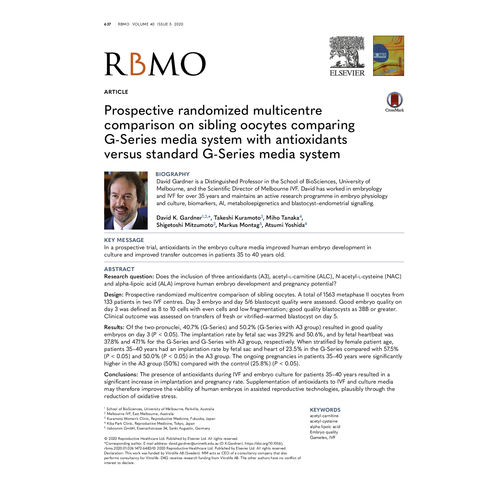Prospective randomized multicentre comparison on sibling oocytes comparing G-Series media system with antioxidants versus standard G-Series media system | Melbourne IVF
By Professor David Gardener
Abstract
Research question
Does the inclusion of three antioxidants (A3), acetyl-l-carnitine (ALC), N-acetyl-l-cysteine (NAC) and alpha-lipoic acid (ALA) improve human embryo development and pregnancy potential?
Design
Prospective randomized multicentre comparison of sibling oocytes. A total of 1563 metaphase II oocytes from 133 patients in two IVF centres. Day 3 embryo and day 5/6 blastocyst quality were assessed. Good embryo quality on day 3 was defined as 8 to 10 cells with even cells and low fragmentation; good quality blastocysts as 3BB or greater. Clinical outcome was assessed on transfers of fresh or vitrified–warmed blastocyst on day 5.
Results
Of the two-pronuclei, 40.7% (G-Series) and 50.2% (G-Series with A3 group) resulted in good quality embryos on day 3 (P < 0.05). The implantation rate by fetal sac was 39.2% and 50.6%, and by fetal heartbeat was 37.8% and 47.1% for the G-Series and G-Series with A3 group, respectively. When stratified by female patient age, patients 35–40 years had an implantation rate by fetal sac and heart of 23.5% in the G-Series compared with 57.5% (P < 0.05) and 50.0% (P < 0.05) in the A3 group. The ongoing pregnancies in patients 35–40 years were significantly higher in the A3 group (50%) compared with the control (25.8%) (P < 0.05).
Conclusions
The presence of antioxidants during IVF and embryo culture for patients 35–40 years resulted in a significant increase in implantation and pregnancy rate. Supplementation of antioxidants to IVF and culture media may therefore improve the viability of human embryos in assisted reproductive technologies, plausibly through the reduction of oxidative stress.

